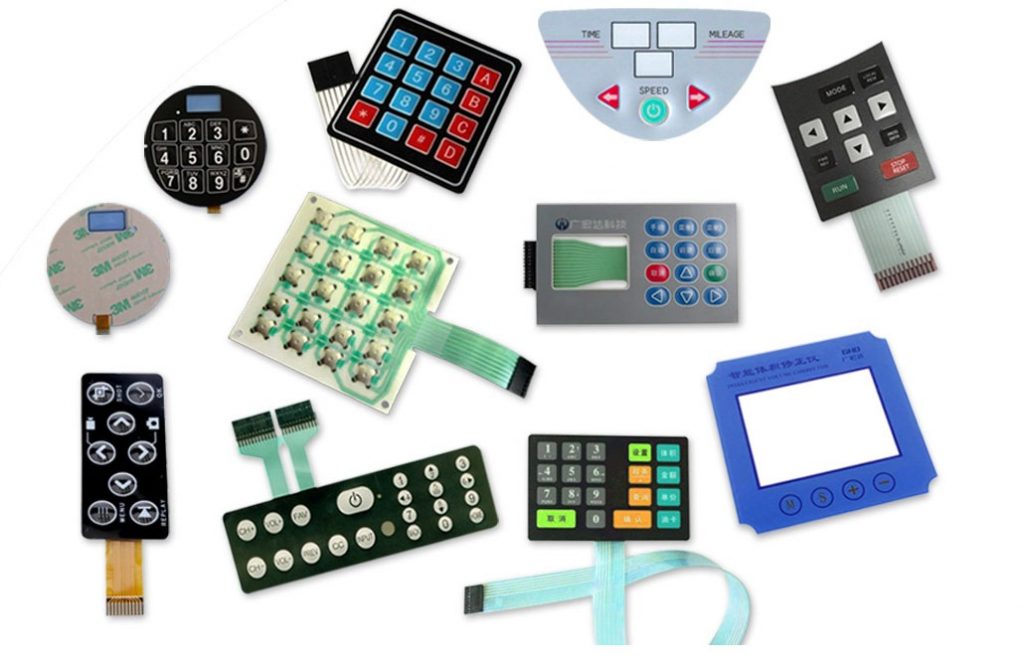Membrane switch in consumer electronics: manufacturing considerations
Everything About Membrane Change: A Comprehensive Overview for Beginners
Membrane layer buttons are crucial components in modern electronics, supplying an unique interface for customer communication - membrane switch. Their split building and construction, including overlays and conductive traces, offers performance and longevity. Unlike standard mechanical buttons, membrane layer switches provide a streamlined design and customizable choices. Recognizing their vital attributes and benefits can transform product layout. The ins and outs of their application and design factors to consider call for further exploration.
What Is a Membrane Change?
A membrane switch is a kind of electrical button that includes an adaptable membrane layer layered over a printed motherboard. This design enables a small and streamlined interface, commonly made use of in different electronic gadgets. Membrane switches are typically discovered in customer devices, clinical tools, and industrial equipment due to their toughness and resistance to environmental factors.The building normally consists of multiple layers, such as graphic overlays and sticky backing, which provide tactile comments and secure the wiring beneath. The procedure of a membrane layer switch is started when pressure is used to the surface area, completing an electrical circuit.These buttons are valued for their adaptability, allowing personalized layouts and printed graphics that deal with particular interface. Their low-profile nature lowers space requirements, making them excellent for applications where typical switches may not fit. Generally, membrane layer buttons use a aesthetic and practical option for contemporary digital devices.
Secret Elements of Membrane Layer Changes
Membrane switches over consist of a number of essential parts that add to their performance and performance. The leading layer, referred to as the overlay, gives the customer interface and is typically published with icons or graphics. Under the overlay lies a spacer layer, which separates the conductive aspects and protects against unintended activation. The following crucial part is the graphic layer, which improves aesthetic appeals and ensures the longevity of the design.Conductive traces, commonly made from materials like silver or carbon, are published on the circuit layer. When pressure is related to the overlay, these traces enter into get in touch with, completing the circuit. In addition, a backing layer provides structural support and can be made from products such as polyester or polycarbonate. With each other, these parts develop a trustworthy, straightforward interface suitable for various applications, from family devices to industrial equipment. Recognizing these components is essential for any person curious about membrane switch innovation.
How Membrane Layer Changes Work
Recognizing how membrane layer changes feature is important for appreciating their widespread use in different gadgets. A membrane layer button runs via a collection of layers, including a visuals overlay, spacer, and a circuit layer. When pressure is related to the overlay, it compresses the spacer layer, permitting the circuit layer to make contact and finish an electrical circuit. This activity sends a signal to the gadget, triggering an action, such as switching on a light or activating a function.Membrane switches over can be developed with different functions, consisting of responsive comments, backlighting, and custom graphics, boosting individual communication. Their construction allows for a sealed design, shielding the interior parts from dirt, moisture, and impurities. This toughness makes them ideal for varied applications, from customer electronics to commercial tools. Overall, the simplicity and performance of membrane switches add to their popularity in modern-day innovation.
Advantages of Membrane Switches Over Mechanical Buttons
While mechanical buttons have long been a staple in many tools, membrane layer switches over deal distinctive advantages that make them progressively appealing. One considerable advantage is their slim profile, permitting even more compact layouts and higher adaptability in item development. Furthermore, membrane switches attribute an uniform surface, which enhances aesthetic allure and simplifies cleansing, making them ideal for atmospheres where health is critical.Another benefit is their resistance to dust and dampness. Unlike mechanical switches, which can be jeopardized by ecological elements, membrane layer switches supply a covered user interface that safeguards versus impurities - membrane switch. Membrane layer switches typically have a longer life expectancy due to fewer relocating parts, resulting in boosted durability and reliability.Cost-effectiveness is additionally a remarkable advantage, as membrane layer buttons can be produced in bulk with lower production expenses. These aspects integrate to position membrane buttons as a useful choice to standard mechanical options in different applications
Usual Applications of Membrane Changes
Membrane buttons are widely utilized in numerous industries, especially in customer electronics and industrial control board. In customer tools, they offer a smooth, straightforward interface, while in industrial settings, they improve durability and functionality. Comprehending these applications highlights the convenience and practicality of membrane switches in contemporary innovation.
Customer Electronic Devices Instruments
As customer electronic devices remain to progress, membrane layer buttons have actually come to be a preferred option for a selection of gadgets as a result of their flexibility and smooth style. These buttons are generally located in smartphones, tablets, and remote controls, where space is limited and looks issue. Their reduced account and adjustable styles enable makers to produce easy to use interfaces that enhance the overall user experience. Additionally, membrane buttons are often used in devices such as microwaves and coffee manufacturers, supplying instinctive control choices while withstanding wetness and dirt. The resilience and reliability of membrane layer switches over make them ideal for daily consumer items, making certain durability and consistent performance. On the whole, their combination in consumer electronic devices shows a blend of capability and contemporary design.
Industrial Control Panels
The applications of membrane layer changes expand past consumer electronic devices, discovering substantial use in industrial control panels. These buttons are favored for their longevity and resistance to extreme atmospheres, making them optimal for manufacturing and process control setups. They supply a reputable interface for drivers to regulate machinery, display processes, and readjust settings. Membrane layer switches can be personalized to suit certain operational demands, including functions like backlighting and responsive feedback, boosting user experience. Their low-profile layout enables for assimilation into different tools, while their ability to hold up against spills, dust, and extreme temperature levels guarantees durability. On the whole, membrane switches add to reliable and safe operation in industrial applications, demonstrating their convenience and effectiveness sought after settings.
Considerations for Designing Membrane Changes
When making membrane switches, choosing the ideal products is important to guarantee toughness and capability. Additionally, understanding layer configuration methods can substantially influence the button's efficiency and individual experience. These factors to consider play an important role in producing dependable and effective membrane layer button layouts.
Product Choice Value
Product choice plays a crucial duty in the layout and capability of membrane layer buttons. The selected materials directly affect the button's longevity, responsive feedback, and total visual. Secret considerations include the substratum, which have try here to give architectural stability while enabling flexibility, and the graphic overlay, which requires to be immune to wear and environmental variables. Conductive products must ensure reputable electrical performance, while adhesives have to supply strong bonding without compromising the switch's procedure. In addition, compatibility with producing processes and end-user settings is crucial; materials must hold up against varying temperatures, moisture levels, and chemical direct exposure. Eventually, appropriate product selection not just improves the membrane button's performance however also adds to its durability and customer contentment, making it an important aspect of the layout process.

Layer Arrangement Techniques

Often Asked Inquiries
For How Long Do Membrane Changes Commonly Last?
Membrane buttons generally have a life expectancy of 1 to 5 million cycles, depending on usage and ecological problems. Factors such as style top quality and operating frequency considerably affect their resilience and general efficiency longevity.

Can Membrane Changes Be Personalized for Particular Designs?
Membrane layer buttons can undoubtedly be tailored to accommodate specific layouts, permitting for varied shapes, shades, and capabilities. This adaptability allows producers to customize these buttons to meet unique visual and operational needs successfully.
What Materials Are Used in Membrane Layer Change Construction?
Membrane layer switches are commonly built making use of materials such as polyester, polycarbonate, and glue layers. These materials supply resistance, toughness, and flexibility to environmental aspects, making certain the switches work properly in various applications and conditions.
Are Membrane Changes Resistant or water resistant to Dampness?
Membrane layer buttons can be developed to be moisture-resistant, using specialized materials and finishings. Nonetheless, you can look here their water-proof capabilities depend on construction high quality and certain applications, making it crucial to assess demands for optimal efficiency in numerous settings.
How Are Membrane Switches Fixed if Harmed?
Repairing damaged membrane switches typically involves changing the influenced layer or circuit. Professionals might likewise apply conductive adhesive or make use of specialized fixing sets, making sure performance is restored without full substitute of the entire switch setting up. Unlike standard mechanical switches, membrane buttons provide a sleek layout and adjustable options. A membrane layer button is a type of electric switch that consists of an adaptable membrane layer layered over a printed circuit board. The procedure of a membrane button is launched when pressure is used to the surface, finishing an electrical circuit.These switches are valued for their convenience, allowing custom layouts and printed graphics that provide to details individual interfaces. While mechanical switches have actually long been a staple in many tools, membrane switches over offer distinctive advantages that make them significantly appealing. Membrane switches usually have a longer life expectancy due to less moving components, resulting in enhanced longevity and reliability.Cost-effectiveness is a fantastic read likewise a remarkable benefit, as membrane layer switches can be created in mass with lower production prices.